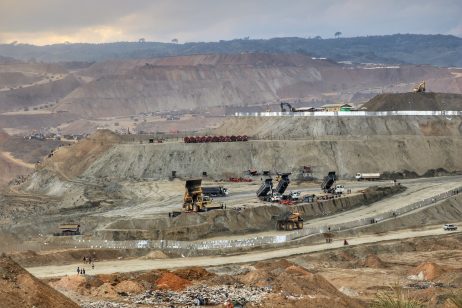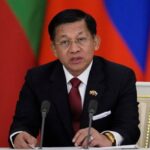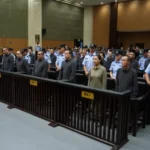Myanmar is China’s top source of raw rare earth elements. As conflict threatens that supply chain, Beijing is moving more directly to intervene in Myanmar’s civil war.

Amid the ongoing conflicts between Myanmar’s military junta and various ethnic armed groups, two recent meetings – one between representatives of the Kachin Independence Army and Chinese officials, and the other between the Myanmar junta and the Myanmar National Democratic Alliance Army (MNDAA) – have taken place in Yunnan, China, which borders northern Myanmar. China, acting not only as a mediator but also as a stakeholder, has been actively involved in the conflict developments in the northern and northeastern parts of Myanmar.
This neighboring country forms a crucial part of Beijing’s global strategy to secure access to critical minerals (rare earths and other minerals, including copper, lithium, nickel and cobalt, etc.) – particularly amid intensifying geostrategic competition with the United States over renewable energy and advanced technologies, both of which heavily rely on rare earths production.
China, the world’s largest producer of rare earth elements, accounts for nearly 90 percent of global processing capacity for these critical metal compounds. Still, a significant portion of the raw materials refined in China is imported from other countries. Specifically, the three primary sources are Myanmar, Laos, and Malaysia, with Myanmar being the top supplier. In 2024, Myanmar delivered 44,000 tonnes of rare earth elements to China, which comprised approximately 57 percent of Beijing’s total rare earth imports. Accordingly, a supply chain has emerged in which rare earth extraction occurs in Myanmar and processing takes place in China.
China’s supply chains – and thus the world’s supply chains, and the global green energy transition – heavily rely on the mining industry in Myanmar, especially in the northern part of the country. The stability of northern Myanmar, including Kachin State, has a direct impact on the mineral trade with China, prompting Beijing to position itself as a stakeholder amid the ongoing conflict between the junta regime and local rebels.
Critical Minerals Amid the China -U.S. Rivalry
Critical minerals, including rare earth elements, are essential to the green energy transition as well as widely used in technological applications – from semiconductors to batteries for smartphones and computers. Military systems are no exception, making these minerals a key national security concern in the geostrategic rivalry between the United States and China. Washington has limited industrial capacity to process rare earth materials at scale, and its resulting dependence on China poses significant national security risks, as illustrated by Beijing’s weaponization of rare earth export restrictions in the China-U.S. trade war. Therefore, reducing reliance on Chinese critical mineral supply chains, including the formation of minilateral coalitions (such as the Mineral Security Partnership), has become a strategic priority for the United States.
Meanwhile, China has continued to expand its global presence in the critical mineral sector by pursuing a strategic acquisition approach. State-owned enterprises and mining companies backed by Chinese banks have come to dominate the nickel and cobalt industries in Indonesia and the Democratic Republic of Congo (DRC), respectively. Notably, the DR Congo has seen expanded mining of critical minerals – including cobalt, uranium, and copper – despite the persistence of violent unrest. Amid the ongoing domestic conflict between the DRC government and the M23 rebel group, reportedly backed by Rwanda, China has not only supplied arms to the DRC, but also secured greater access to the country’s mineral resources, particularly during the Joseph Kabila regime. This reflects the complex dual economic-military relationship between Beijing and Kinshasa, which in turn poses challenges for other foreign countries seeking access to DRC’s mining sector.
Beijing’s Approach in Myanmar
Like the DRC, Myanmar boasts rich natural resources but is roiled by conflict. Since the 2021 coup in Myanmar, China has been widely regarded as the junta’s primary external sponsor, despite the military regime’s ongoing crackdowns on domestic opposition and ethnic minority groups. In a quid pro quo, the junta has permitted the expansion of unregulated mining operations in Kachin State, many of which are supplying Chinese entities.
As a major source of revenue for both the junta and local rebel groups, mineral and jade mining sites have become flashpoints for armed conflict. Undoubtedly, one of Beijing’s core interests in Myanmar is the stability of the country’s northern territories, as this is a necessary prerequisite for continued mining operations and cross-border resource trade with China. In a recent example, the prices of certain rare earth elements (such as terbium) spiked in October 2024, likely due to supply chain disruptions when the Kachin Independence Army (KIA) took control of the region, including mining sites around towns like Panwa and Chipwe. These areas had been previously controlled by the New Democratic Army – Kachin (NDA-K), a militia group allied with the junta. More broadly, the KIA has sought to leverage rare earth resources as a bargaining tool with the Chinese government, beginning by imposing an additional tax on Chinese-owned mining sites.
Beyond Kachin, the economy of Kokang – a northeastern region of Shan State – relies primarily on cross-border, and notoriously ill-regulated, trade with China’s Yunnan Province, particularly in timber and agricultural products. Clashes between the Myanmar military and the MNDAA have persisted since Kokang was taken over by the central government in 2009. However, in August 2024, the MNDAA successfully expelled government forces from Lashio, a city that serves as a strategically vital gateway for trade with China.
As the primary regional power maintaining relations with both the Myanmar junta and the MNDAA, China brokered a ceasefire after cutting off power, water, and internet access to MNDAA-controlled Kokang. This move compelled the MNDAA to return Lashio to central government control without a single shot being fired, signaling Beijing’s continued alignment with the junta as a central approach for deescalating instability in the Kokang region.
Whether Beijing would employ a similar approach in Kachin State against the KIA remains uncertain. On the one hand, Kachin’s trade dependence on China and the presence of Chinese-backed infrastructure projects provide Beijing with leverage to negotiate with the KIA, potentially enabling the resumption of mining operations and mineral exports aligned with Chinese interests, as was the case prior to the region falling under KIA control. On the other hand, such a strategic objective may prove difficult to realize, as the rare earth resources located within KIA-controlled areas represent its most significant bargaining asset. Furthermore, India’s expression of interest as a potential investment partner for the KIA complicates Beijing’s position.
Given the urgent need to secure critical mineral supply chains amid growing competition with Washington. China’s Myanmar policy, which has largely supported the junta, may face a significant test as control over critical minerals becomes increasingly central to geopolitical calculations.
Thank you for reading! Visit us anytime at Myanmar.com for more insights and updates about Myanmar
Related posts:
 Myanmar’s December 2025 Elections: A Carefully Engineered Trap, Not a Genuine Political Transition
Myanmar’s December 2025 Elections: A Carefully Engineered Trap, Not a Genuine Political Transition
 Myanmar Earthquake – A Nation in Crisis Amidst Disaster
Myanmar Earthquake – A Nation in Crisis Amidst Disaster
 WORLD BANK: MARCH EARTHQUAKE TO CAUSE 2.5% DECLINE IN MYANMAR’S GDP
WORLD BANK: MARCH EARTHQUAKE TO CAUSE 2.5% DECLINE IN MYANMAR’S GDP
 SpaceX Cuts Starlink Access at Myanmar Scam Compounds
SpaceX Cuts Starlink Access at Myanmar Scam Compounds
 US Removes Myanmar Junta Allies From Sanctions List
US Removes Myanmar Junta Allies From Sanctions List
 China Executes 16 Tied to Myanmar Crime Syndicate
China Executes 16 Tied to Myanmar Crime Syndicate
